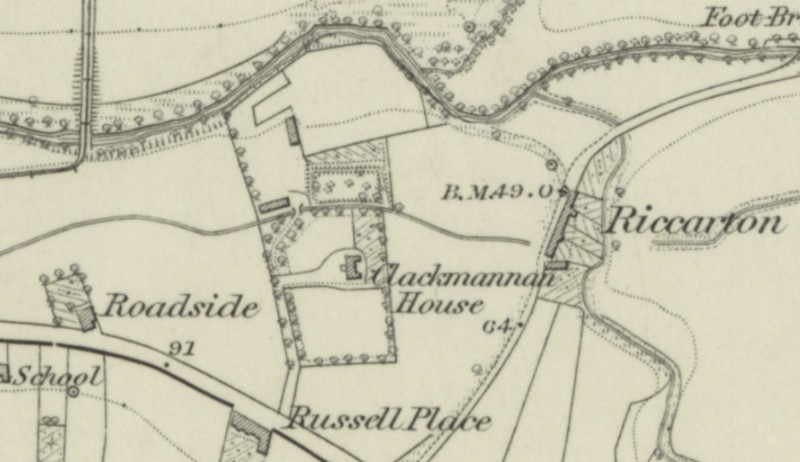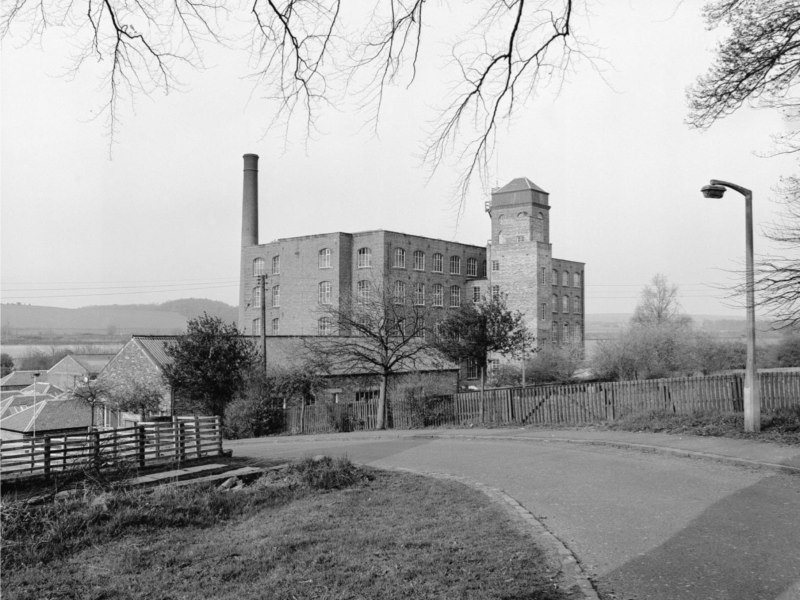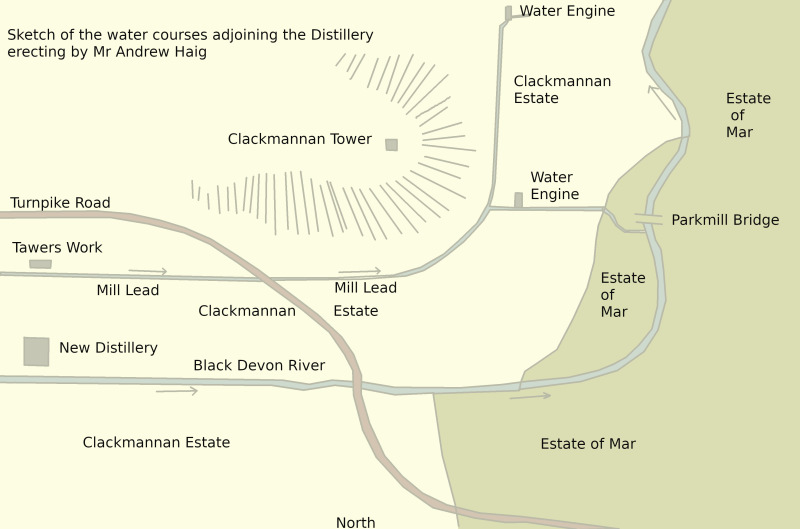Clackmannan once hosted a Lowland region distillery. Clackmannan Distillery stood on the south bank of the Black Devon on the edge of Clackmannan. The distillery was built by Andrew Haig at some point prior to 1814. Canmore dates Clackmannan House, an integral part of the distillery site, at around 1815, It is also noted as being one of the sizable distilleries of the county in the book "A General View of the Agriculture of the Counties of Kinross and Clackmannan", published in 1814.
In the excise accounts covering 10th November 1820 to 10th February 1821, Clackmannan distillery is listed as having a Wash Still of 878 Gallons, Low Wines Still of 1781 Gallons, and having produced 27, 569 gallons of spirits in that time period.
Andrew Haig
Andrew Haig, born in Alloa in 1769, was part of a large family, many of whom were to run or own distilleries in later life. He stayed for a time at the Kilbagie Distillery, where he had been an apprentice for his uncle, James Stein. In the Morning Chronicle, February 1820, Andrew Haig was listed as ‘of Clackmannan’. He died in 1824, aged 55. He was not married.
John Stein & Co.
John Stein & Co. took over Clackmannan Distillery from Andrew Haig in 1821.^
Clackmannan House was situated to the south of the Clackmannan Distillery, and is still in existence. It was noted as being the residence of John Stein, Distiller, in the Pigot's Directory of 1837. The distillery is also mentioned as extant. Clackmannan House still exists.

OS Map showing Clackmannan House and the Clackmannan Distillery site to the north of it (though not labelled) circa 1840.
Clackmannan Distillery
The distillery is not shown on any of the OS maps widely available, however it gets a mention in the 1845 New Statistical Accounts for the parish, when talking of Kilbagie Distillery - "The Clackmannan distillery, which is adjacent to the town, is a work of much less extent. Whisky has been here made for the home or Scotch market."*
This may indicate that the distillery was still in operation at this time, other sources have suggested that John Stein & Co. operated the distillery until 1833.^
An official report from 1833 shows that Clackmannan Distillery produced 101,994 gallons of spirit that year.
Distillery Auction
Clackmannanshire Council Archives were able to help (thank you once again to Susan Yule from Clackmannanshire Council) with a cutting from the Alloa Advertiser, dated 20th July, 1850, Advertising a public auction of the site, which included Clackmannan House, the text of which is reproduced below:
FOR SALE.
To be Sold, by Public Roup, within the Royal Oak Hotel, Alloa,
Upon Saturday the 17th day of August next, at Two o'Clock Afternoon
The Site of the late CLACKMANNAN DISTILLERY, with the walls of the Distillery standing,
a Dwelling-House, Garden and Lawn, and betwixt Three and Four Acres of Excellent Land.
The property is most pleasantly situated on the south bank of the Black Devon
- an excellent trouting stream - and is in the immediate neighbourhood of the town of Alloa.
It is well adapted either for a Private Residence or for a Distillery, Brewery, or Manufactory.
The Dwelling-House is of moderate and substantial construction, stone-built, and slated.
It is large and commodious, containing, on the Ground Floor a front and back kitchen
(in the former of which there is an excellent Steam-Cooking Apparatus),
a dairy, servants' room, cellar, and other conveniences.
On the First Floor, a dining-room, drawing-room, parlour, and hall;
and on the Second floor, four bed-rooms, dressing-room, closets, etc.
There are also two water-closets; besides sculleries, within the house.
The Garden and Lawn contain nearly an acre and a half of ground.
For a Distillery, Brewery, or Manufactory, the situation is peculiarly suitable, being about 300 yards from
the Dunfermline and Stirling Railway, and close by the Clackmannan Coalworks.
There is abundance of water running through the Property, and also a large reservoir on it, 164 feet long by 81 feet wide.
Miss Wilson, who resides in the House, will show it and the Garden; and for further particulars
application may be made to Messrs Ramsay and McWatt, Writers, Alloa;
or Messrs Tods and Romanes, W.S., Edinburgh, who are in possession of the title-deeds and articles of roup.
Clackmannan Woollen Mill
A comparatively new industry was started in the parish of Clackmannan when in 1875, Messrs. Patons of Alloa erected a subsidiary mill on the banks of the Black Devon. It was built on the pattern of the typical Lancashire mill, that of a square block of flats with no pretensions to architectural beauty. The site chosen was that of the old distillery of the town, and the wall of the previous building still stands. The mill was built by Messrs. Charles Buick & Sons, a local firm, and it is said that the cost was no more than £1,500, a figure that strikes us to-day as fantastically low. The machinery was installed in August 1876 and the mill was working soon after.

OS Map showing Clackmannan House and the Clackmannan Woollen Mill site to the north of it.
There has been a remarkable increase in output in recent times. Between the two wars the production was about 1,000,000 lb, of wool per annum, but since 1945 it has soared to 1,500,000 lb. The mill converts the heavier wools into yarn by means of teasing, carding and spinning, the finishing processes being done in the parent mill in Alloa.**

Clackmannan Woollen Mill. Picture - Canmore.org
Clackmannan House is just off the picture to the right.
Much of the road (Mill Road) still exists.
The mill closed in the 1980s, and the site was redeveloped for housing, the area commonly known now as Cherryton, with a new access road taken from the Riccarton road. The vehicle access from Helensfield was stopped, reduced to pedestrian access only.
Virtually the only remnants of the area's industrial past are at the pedestrian bridge over the river and a walled bank on the south side of the river, possibly with signs of a water wheel having been mounted there. The Woollen Mill was originally steam powered, so any wheel would have been part of the distillery workings.
As with the other pages on the site, this is only what we have so far. If you have information that you can share, please get in touch.
National Records of Scotland - RHP13276
We purchased a digital copy of this document from NRS - It is not dated in any way, but it does outline the border between the Mar Estate and the Clackmannan Estate to the north and west of Kingseat Hill. Clackmannan Tower, the Black Devon river, Mary Bridge and Parkmill Bridge are all mapped, as well as the Distillery and the 'Mill Lead' which is shown as powering two 'water engines' located roughly at Speedwell and Westfield. These would have been used to pump water from the coal workings there. The 'Mill Lead' originated at Linn Mill, where there was a small dam and weir. The Clackmannan Field Studies Society have investigated this system in the past, and produced a report.
The original document image itself cannot be posted here due to copyright, so I have made a sketch of the sketch.

References:
* New Statistical Account of Scotland - Clackmannan Parish
Pigot's National Commercial Directory, August 1837
** Third Statistical Account of Scotland - Clackmannan Parish
^ wormtub.com
Canmore.org.uk
A General View of the Agriculture of the Counties of Kinross and Clackmannan - Patrick Graham D. D. Minister of Aberfoyle
Clackmannan Council Archives
National Records of Scotland - RHP13276 - 'Sketch of the water courses adjoining the distillery erecting by Mr Andrew Haig.'
